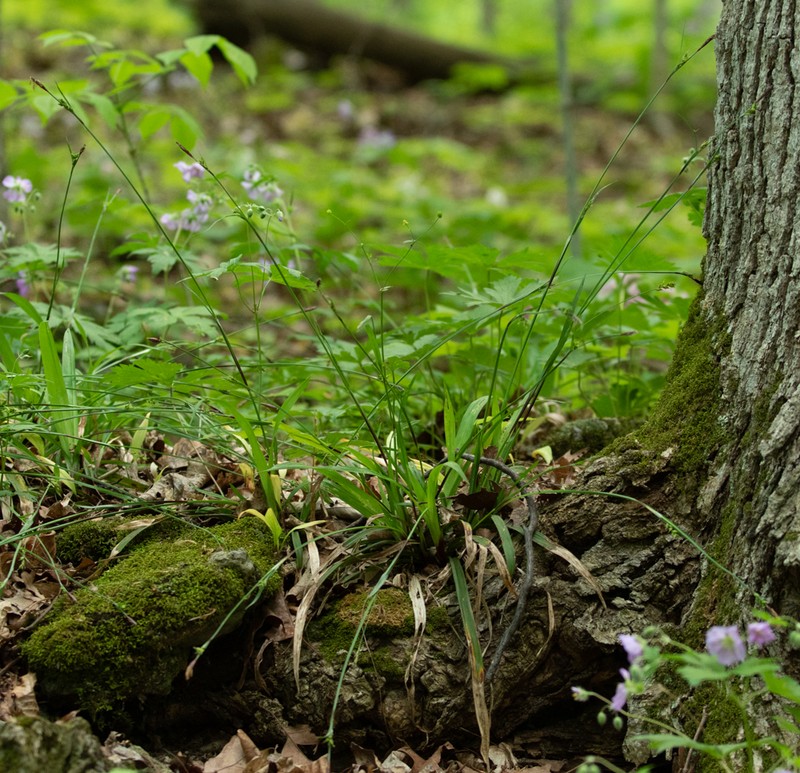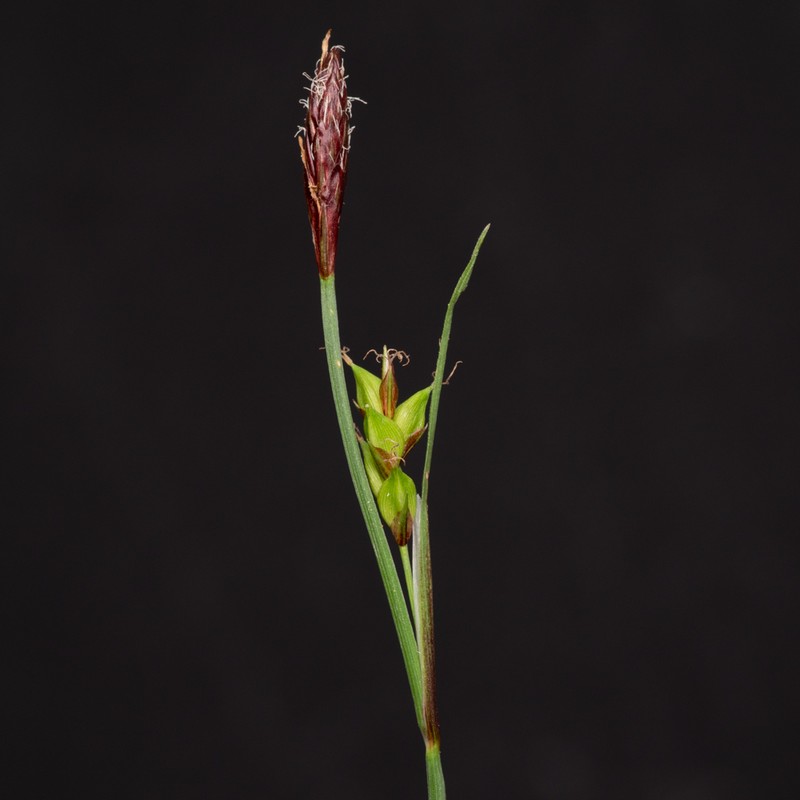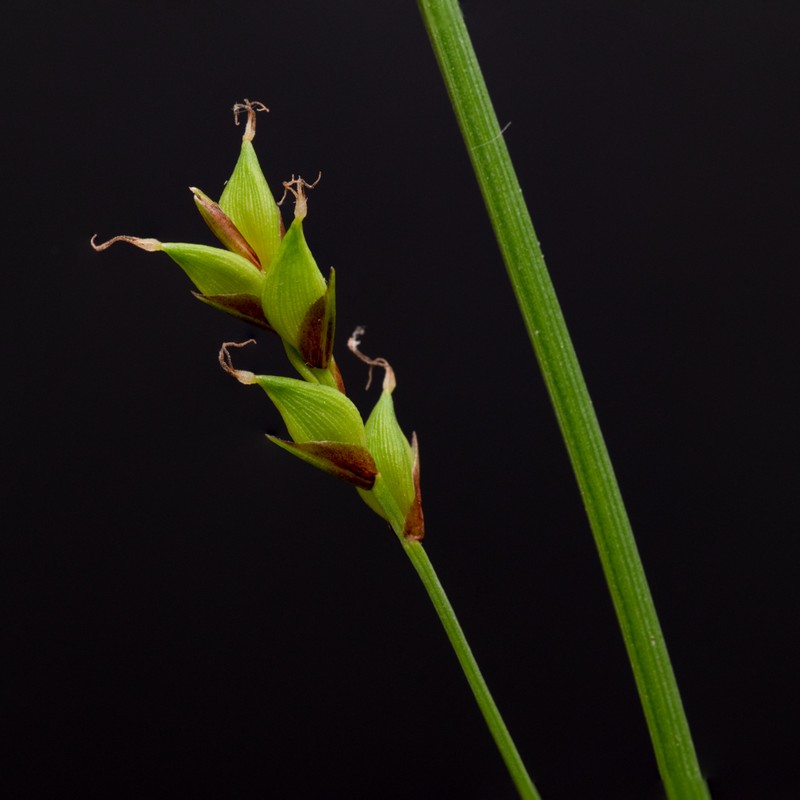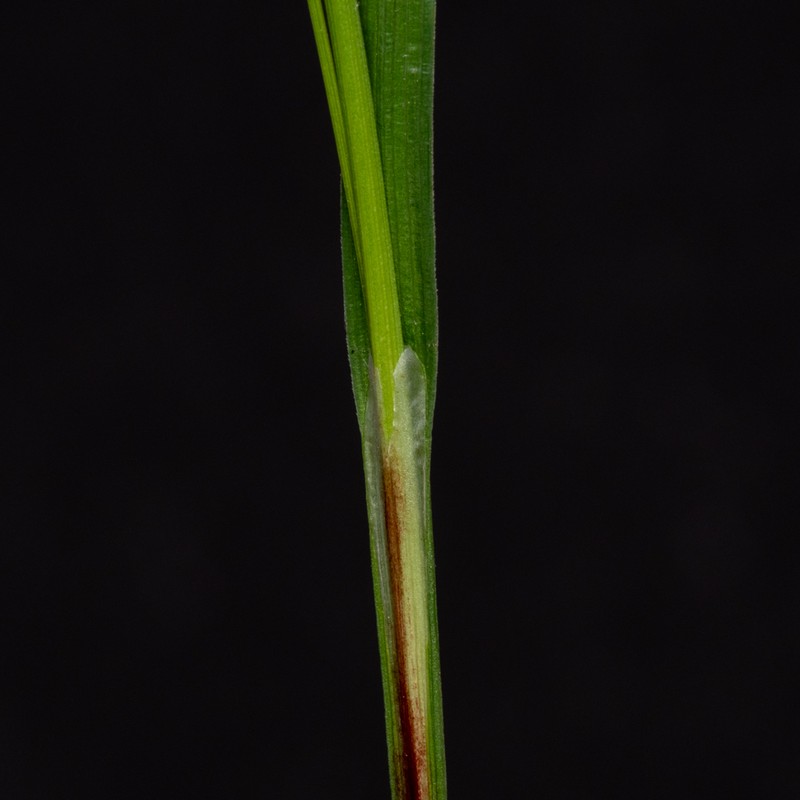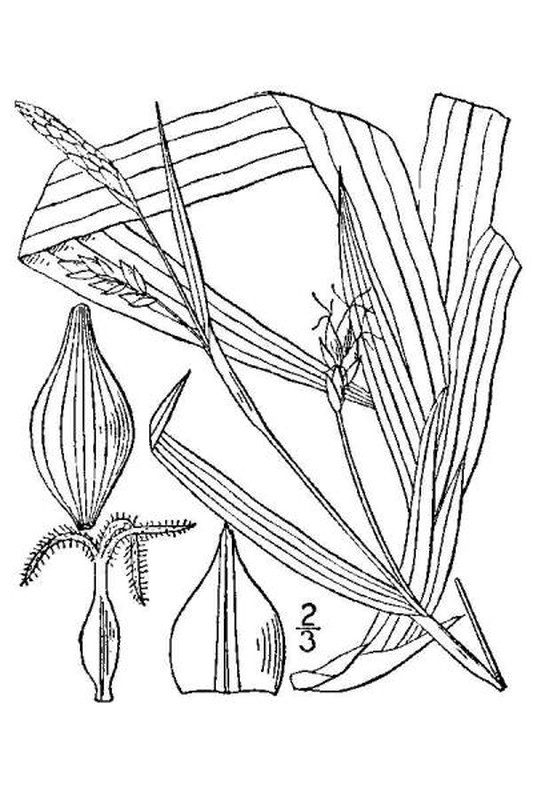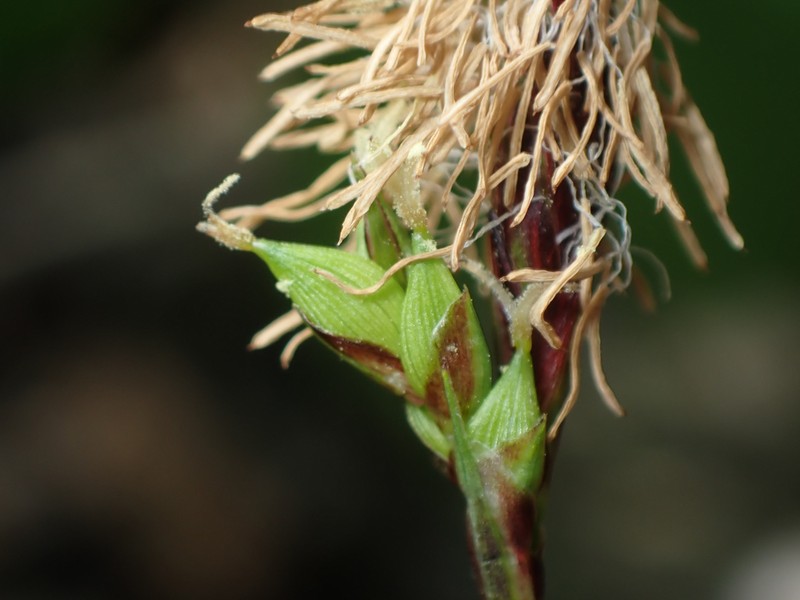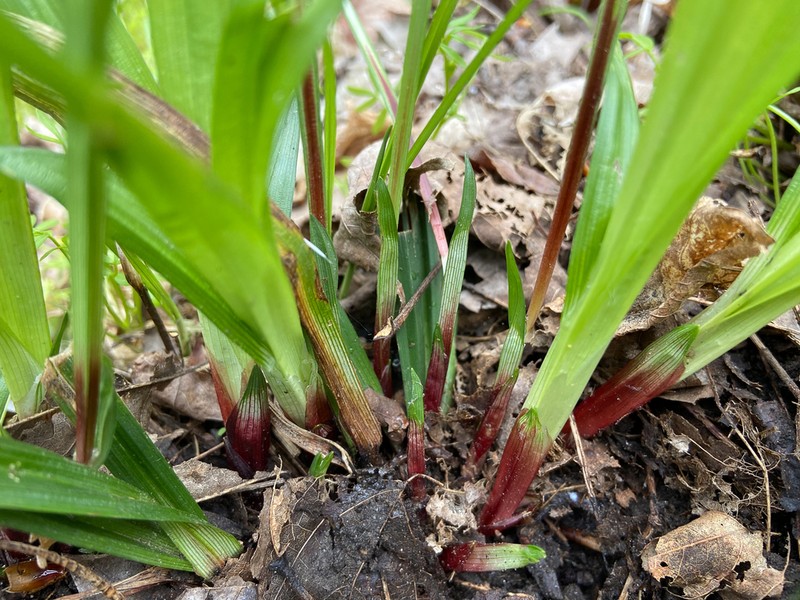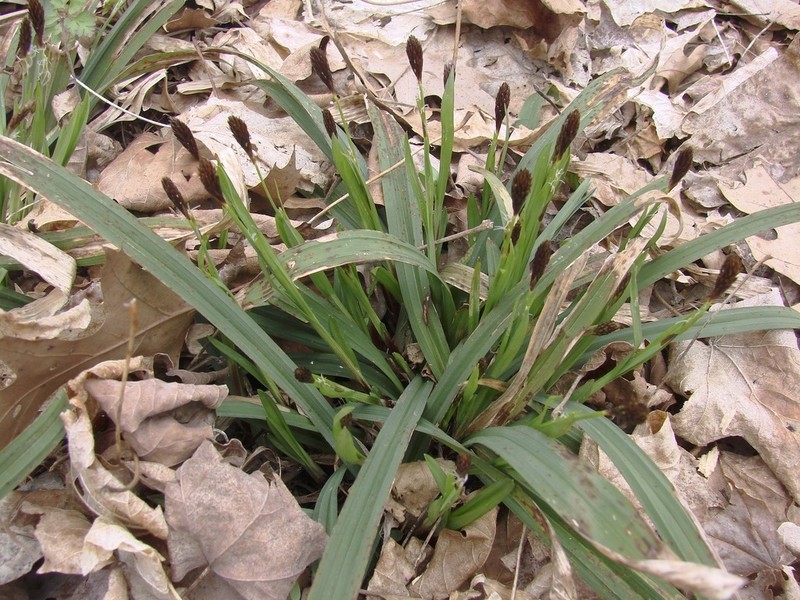Carey's Sedge
Carex careyana Torr. ex Dewey
- Class
- Monocotyledoneae (Monocots)
- Family
- Cyperaceae (Sedge Family)
- State Protection
- Endangered
Listed as Endangered by New York State: in imminent danger of extirpation in New York. For animals, taking, importation, transportation, or possession is prohibited, except under license or permit. For plants, removal or damage without the consent of the landowner is prohibited.
- Federal Protection
- Not Listed
- State Conservation Status Rank
- S1S2
Critically Imperiled or Imperiled in New York - Especially or very vulnerable to disappearing from New York due to rarity or other factors; typically 20 or fewer populations or locations in New York, very few individuals, very restricted range, few remaining acres (or miles of stream), and/or steep declines. More information is needed to assign either S1 or S2.
- Global Conservation Status Rank
- G4G5
Apparently or Demonstrably Secure globally - Uncommon to common in the world, but not rare; usually widespread, but may be rare in some parts of its range; possibly some cause for long-term concern due to declines or other factors. More information is needed to assign either G4 or G5.
Summary
Did you know?
This species is named after the botanist John Carey (1797-1880) who collected the type specimen near Auburn NY in 1832 (Wiegand and Eames 1926).
State Ranking Justification
Based on herbarium records, this sedge is limited to central and northern New York. The habitat is limestone woodlands. Currently, there are less then three known populations. Most of the herbarium records are pre-1950, and these are from a relatively small range.
Short-term Trends
This species was only recently added to the active list of monitored plants in NY and there is no information available on how populations have been changing recently. So, short term trends are unknown.
Long-term Trends
There are about four extant populations most of which were not known previous to their recent discovery but were probably overlooked in the past. All other records are historical and have not been seen in at least 20 years but these populations have not been looked for and it is unknown if they are still extant. Therefore, overall long term trends are unknown.
Conservation and Management
Research Needs
Searches need to be done on historical populations to determine if they are still extant.
Habitat
Habitat
Carex careyana occurs in rich forests with deep calcareous soils and limestone forests (New York Natural Heritage Program 2006). Rich, moist deciduous or deciduous-evergreen forests, on slopes, often around limestone escarpments and adjacent rocky woods, washes, sinks, or cave entrances (Bryson and Naczi 2002). Rich woods, often a calciphile (Gleason and Cronquist 1991). Rich hardwoods, local (Fernald 1970). Woodlands, in very rich dark soils over gravel (Wiegand and Eames 1926).
Associated Ecological Communities
- Calcareous talus slope woodland*
(guide)
An open or closed canopy community that occurs on talus slopes composed of calcareous bedrock such as limestone or dolomite. The soils are usually moist and loamy; there may be numerous rock outcrops.
- Limestone woodland
(guide)
A woodland that occurs on shallow soils over limestone bedrock in non-alvar settings, and usually includes numerous rock outcrops. There are usually several codominant trees, although one species may become dominant in any one stand.
- Maple-basswood rich mesic forest
(guide)
A species rich hardwood forest that typically occurs on well-drained, moist soils of circumneutral pH. Rich herbs are predominant in the ground layer and are usually correlated with calcareous bedrock, although bedrock does not have to be exposed. The dominant trees are sugar maple, basswood, and white ash.
- Rich mesophytic forest*
(guide)
A hardwood or mixed forest that resembles the mixed mesophytic forests of the Allegheny Plateau south of New York but is less diverse. It occurs on rich, fine-textured, well-drained soils that are favorable for the dominance of a wide variety of tree species. A canopy with a relatively large number of codominant trees characterizes this forest. Canopy codominants include five or more of the following species: red oak, red maple, white ash, American beech, sugar maple, black cherry, cucumber tree, and black birch.
* probable association but not confirmed.
Associated Species
- Acer saccharum (sugar maple)
- Carex cephaloidea (thin-leaved sedge)
- Carex gracilescens (slender rich woodland sedge)
- Carex hitchcockiana (Hitchcock's sedge)
- Carex jamesii (James's sedge)
- Carex pedunculata
- Carex woodii (Wood's sedge)
- Jeffersonia diphylla (twinleaf)
- Ostrya virginiana (hop hornbeam, ironwood)
- Poa sylvestris (forest blue grass)
- Valerianella chenopodiifolia (goosefoot corn-salad)
Range
New York State Distribution
Carex careyana is known from central, western, and northwestern New York. It is at the northeast edge of its range in New York.
Global Distribution
Carex careyana occurs from New York west to Ontario, Michigan, and Minnesota south to Virginia, Tennessee, Alabama, and Arkansas (Bryson and Naczi 2002).
Identification Comments
General Description
Carex careyana is a tufted, perennial, grass-like plant. Its leaves are fairly broad (4-18 mm wide) and have a few strong longitudinal ribs. The bases of the plants have a distinctive purple color. Stems are 34-62 cm tall and arise out of the leaves at the bases of the plants. A few flower/fruit clusters that are 7-18 mm long occur on erect secondary branches off of the main stem. Fruits (perigynia) are 5-6.6 mm long (Bryson and Naczi 2002).
Identifying Characteristics
Carex careyana is a cespitose perennial. It has basal leaf sheaths distinctly purple at the base. Leaf blades are quite wide (4-18 mm wide) especially for an upland species and are strongly veined. Culms are 34-62 cm long and have (2-)3(-4) spikes per culm. The terminal spike is staminate and 8-20 mm long while the lateral spikes are pistillate, have 4-9 perigynia per spike, and are 7-18 mm long. The bracts that subtend the spikes have blades 2.1-9.2 cm long. The perigynia are 5-6.6 mm long and strongly trigonous in cross section (Bryson and Naczi 2002).
Best Life Stage for Proper Identification
Carex careyana is best identified when it is in fruit although this species is pretty easy to identify when it is in flower or even simply vegetative, if one is familiar with the various broad leaved upland sedges that occur in NY.
Similar Species
Carex careyana is quite similar to C. plantaginea. The leaves of C. plantaginea have a wrinkled or seersucker texture vs. only being longitudinally somewhat folded for C. careyana. In addition C. plantaginea has lower bract blades absent to small (to 2 cm long), perigynia smaller (3.7-4.9 mm long), and lateral spikes with 9-13 perigynia (Bryson and Naczi 2002, New York Natural Heritage Program 2006).
Carex albursina also has broad leaves but the perigynia are obtusely trigonous and the three distal spikes are approximate (vs. only the two distal spikes being some what approximate in C. careyana).
Carex platyphylla also has broad leaves but bases of the basal sheaths are white or brown and the leaves are glaucous when fresh.
Best Time to See
Carex careyana is one of the earlier flowering and fruiting Carex species in New York. It is in immature to mature fruit from mid May to late June although the perigynia are almost completely shed by the end of June. Therefore surveys are most successful from mid-May to mid-June.
- Fruiting
The time of year you would expect to find Carey's Sedge fruiting in New York.
Carey's Sedge Images
Taxonomy
Carey's Sedge
Carex careyana Torr. ex Dewey
- Kingdom Plantae
- Phylum Anthophyta
- Class Monocotyledoneae
(Monocots)
- Order Cyperales
- Family Cyperaceae (Sedge Family)
- Order Cyperales
- Class Monocotyledoneae
(Monocots)
- Phylum Anthophyta
Additional Common Names
- Sedge
Comments on the Classification
Carex careyana is in section Careyanae. It had previously been placed in section Laxiflorae by many authors (e.g. Fernald 1970 and Gleason and Cronquist 1991). Naczi et al. (2001) summarizes the various articles and reasons why section Careyanae should be recognized at the sectional level distinct from section Laxiflorae.
Additional Resources
Best Identification Reference
Bryson, C.T. and R.F.C. Naczi. 2002. Carex Linnaeus sect. Careyanae Tuckerman ex Kakenthal. Pages 443-448 in Flora of North America Editorial Committee (editors), Flora of North America, North of Mexico, Volume 23, Magnoliophyta: Commelinidae (in part): Cyperaceae. Oxford University Press, New York, New York, USA. 608pp + xxiv.
Other References
Fernald, M.L. 1950. Gray's manual of botany. 8th edition. D. Van Nostrand, New York. 1632 pp.
Gleason, Henry A. and A. Cronquist. 1991. Manual of Vascular Plants of Northeastern United States and Adjacent Canada. The New York Botanical Garden, Bronx, New York. 910 pp.
Holmgren, Noel. 1998. The Illustrated Companion to Gleason and Cronquist's Manual. Illustrations of the Vascular Plants of Northeastern United States and Adjacent Canada. The New York Botanical Garden, Bronx, New York.
Naczi, R. F., R. Kral, and C. T. Bryson. 2001. Carex cumberlandensis, a new species of Section Careyanae (Cyperaceae) from the Eastern United States of America. Sida 19(4): 993-1014.
New York Natural Heritage Program. 2010. Biotics database. New York Natural Heritage Program. New York State Department of Environmental Conservation. Albany, NY.
New York Natural Heritage Program. 2024. New York Natural Heritage Program Databases. Albany, NY.
Reschke, Carol. 1990. Ecological communities of New York State. New York Natural Heritage Program, New York State Department of Environmental Conservation. Latham, NY. 96 pp. plus xi.
Weldy, T. and D. Werier. 2010. New York flora atlas. [S.M. Landry, K.N. Campbell, and L.D. Mabe (original application development), Florida Center for Community Design and Research http://www.fccdr.usf.edu/. University of South Florida http://www.usf.edu/]. New York Flora Association http://newyork.plantatlas.usf.edu/, Albany, New York
Wiegand, K.M. and A.J. Eames. 1926. The flora of the Cayuga Lake Basin, New York. Cornell University, Agricultural Experiment Station, Memoir 92, Ithaca, NY. 491 pp + map.
Links
About This Guide
Information for this guide was last updated on: November 4, 2022
Please cite this page as:
New York Natural Heritage Program. 2024.
Online Conservation Guide for
Carex careyana.
Available from: https://guides.nynhp.org/careys-sedge/.
Accessed July 27, 2024.
